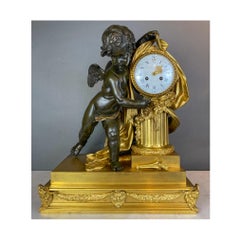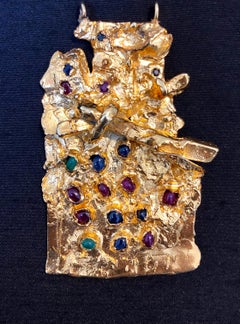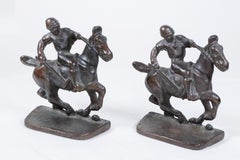F & P Associates More Art
to
1
1
Overall Width
to
Overall Height
to
2
2
2
2
2
Large Neoclassical French Gilt and Silvered Bronze Vase
Located in New York, NY
Large Neoclassical French Gilt and Silvered Bronze Two Handle Vase
A large cylindrical vase with a silvered body and gilt neck and base. Topped by two masks, one modeled after the f...
Category
19th Century More Art
Materials
Bronze
Fine Gilt and Patinated Bronze Mantel Clock with Putti by A Paris
Located in New York, NY
An exquisite figural bronze mantel clock with Putti leaning on clock face which sits on a fluted column draped in garlands and fabrics. Sitting on a r...
Category
19th Century More Art
Materials
Bronze
Related Items
Gold Gilt Bronze Sculpture Pendant Israeli Tumarkin Abstract Modernist Jewelry
Located in Surfside, FL
Measures about 4.25 X 2.25 inches. Box frame is 17 X 13 inches. Signed by artist verso. From the literature that I have seen I believe the edition size was limited to 10, I do not kn...
Category
1960s Modern Abstract Sculptures
Materials
Gold, Bronze
$3,000
H 17 in W 13 in D 2 in
Polo Player Bookends in Bronze
Located in Brookville, NY
Polo Bookends in bronze for the sporty library. These were purchased from the collection of a polo player on Long Island who had a beautiful library of sporting books. He also owne...
Category
1960s Academic Figurative Sculptures
Materials
Bronze
ANCIENT ROMAN BRONZE SCULPTURE FIGURE OF A ROMPING DOG
Located in Milan, IT
"Roman Bronze Figure Of A Romping Dog"
Roman Empire, circa 1st Century B.C.- 1st Century A.D.
Bronze
width 7 cm
width 2 3/4 in
Provenance:
Leo Mildenberg (1913-2001) Private Collection, Zurich, prior to 1986
American Private Collection, acquired in 1991
Literature:
A.P. Kozloff, et al., More Animals in Ancient Art...
Category
15th Century and Earlier Figurative Sculptures
Materials
Bronze
$14,186
H 1.97 in W 2.76 in
Birdman – Contemporary Hybrid Human-Bird Sculpture by Zura
Located in Brooklyn, NY
More than a creature, Birdman embodies transformation and duality. Is it a guardian, a trickster, or an internal self-reflection? Its bird-like head and humanoid stance invite viewer...
Category
21st Century and Contemporary Contemporary Figurative Sculptures
Materials
Bronze
Pickingfisher- original realism wildlife sculpture 3d artwork - contemporary art
By Henk Jan Sanderman
Located in London, Chelsea
This exceptional artwork is currently on display and available for sale at Signet Contemporary Art Gallery and online.
Brimming with narrative energy, “Pickingfisher” plunges into a...
Category
21st Century and Contemporary Modern Sculptures
Materials
Bronze
$3,007
H 15.75 in W 11.82 in D 3.94 in
"Evening Roost" Wildlife Bronze Sculpture of Green-Wing Teal Ducks Ed. 34/40
Located in Houston, TX
Naturalistic bronze wildlife sculpture by Texas based artist Ronnie Wells. The work features a pair of green-wing teal ducks by the water as they inspect a snail. Titled, signed, and...
Category
1980s Naturalistic Still-life Sculptures
Materials
Bronze
$3,450
H 15 in W 20.75 in D 13 in
"De Draeger" bronze medallion with book
By Salvador Dalí
Located in Chatsworth, CA
De Draeger, 1961
Bronze Medallion with book
Numbered 1032 from the edition of 1500
Bronze Medallion: 3-1/8 inches (8 cm) diameter, numbered "1032" on verso of medallion
Portfolio Siz...
Category
1960s Modern More Art
Materials
Bronze
Rooster & Ermine
By Jules Moigniez
Located in Milford, NH
A monumental 19th century patinated animalier cast bronze of a rooster & ermine (weasel), with varying titles including "Coq Guettant," "Coq Attaquant une Belette," and "Cockerel and...
Category
19th Century Figurative Sculptures
Materials
Bronze
Arabesque, Female Ballet Dancer in Motion, Bronze Gray Bas Relief Sculpture Art
By Eric Bransby
Located in Denver, CO
This stunning figurative bas relief sculpture captures a female ballet dancer gracefully poised in the arabesque position, created by the acclaimed Colorado/Missouri artist Eric Bransby (1916-2020). Crafted from bronze and polymer Forton casting, the piece beautifully exemplifies Bransby’s mastery of motion and form.
Provenance:
Collection of the artist, Eric Bransby
About Eric Bransby:
Eric James Bransby was a highly respected muralist, painter, illustrator, and educator. His education at the Colorado Springs Fine Art Center included studies with renowned artists like Thomas Hart Benton, Jean Charlot, Boardman Robinson, and Josef Albers. He also studied at the prestigious Yale School of Fine Art.
Bransby’s career is defined by his exceptional work as a muralist, with notable commissions including the Rockhurst Library Triptych Mural at the University of Missouri, murals at Brigham Young University, the U.S. Air Force Academy...
Category
20th Century American Modern Figurative Sculptures
Materials
Bronze
$6,400 Sale Price
20% Off
H 40 in W 30 in D 3 in
Elevated - original realism wildlife sculpture 3d artwork - contemporary art
By Henk Jan Sanderman
Located in London, Chelsea
This exceptional artwork is currently on display and available for sale at Signet Contemporary Art Gallery and online.
Striking a balance between whimsy and wonder, “Elevated” by He...
Category
21st Century and Contemporary Modern Sculptures
Materials
Bronze
Henk Jan SandermanElevated - original realism wildlife sculpture 3d artwork - contemporary art, 2025
$3,007
H 15.75 in W 11.82 in D 3.94 in
"Dancer with the scarf" lamp
By Agathon Léonard
Located in PARIS, FR
Agathon LÉONARD (1841–1923)
Lamp "Danseuse à L'Écharpe"
"Dancer with the scarf" lamp
A very rare sculpture forming a table lamp, made in gilded bronze
The scarf hides the light bulb
Signed on the side of the dress "A. Léonard Sclp"
Cast by Susse Frères (with founder stamp)
France
circa 1905
height 60 cm
A similar model is reproduced in "Les bronzes du XIXe siècle", P. Kjellberg, Les éditions de l'amateur, 2005, page 460.
Biography:
Léonard Agathon Van Weydeveldt, said Agathon Léonard (1841-1923) was a sculptor of Belgian origin naturalized French. After studying art at the Lille Academy of Fine Arts and then at the École des Beaux-Arts in Paris, Agathon Léonard settled in Paris for a long time, where after having exhibited at the Salon of 1868, he joined the Society of French artists in 1887, then to the National Society of Fine Arts in 1897. Very involved in the artistic movement of the Art Nouveau style, he exhibited many pieces (medallions, bronze statuettes and ceramics) finely worked.
Following an order from the Manufacture Nationale de Sèvres, dating from 1898, Agathon Léonard exhibited at the Universal Exhibition of 1900 in Paris his famous table centerpiece "Game of the scarf" in porcelain biscuit, composed of fifteen statuettes representing dancers with pleated dresses reminiscent of Loïe Fuller's choreographies or Neo-Greek dancers...
Category
Early 1900s Art Nouveau More Art
Materials
Bronze
Empire Bronze Torchere Lamps
Located in Los Angeles, CA
A pair of gilded bronze torchere lamps with Alabaster shades on top and exquisite detailed bottom part supported by multi level round carved marble base.
Measurement: 91”height x 2...
Category
Late 19th Century Victorian More Art
Materials
Bronze



